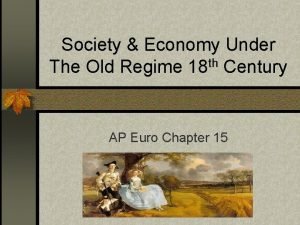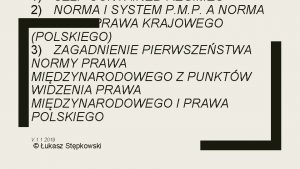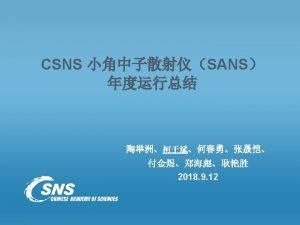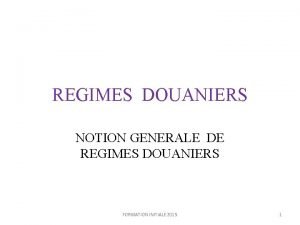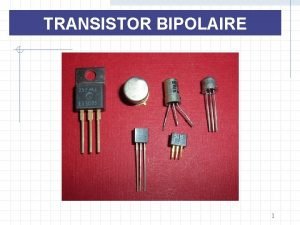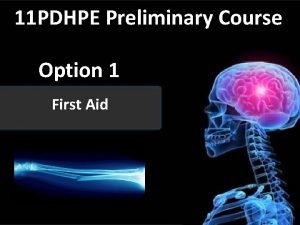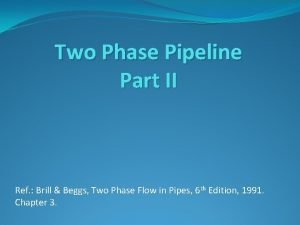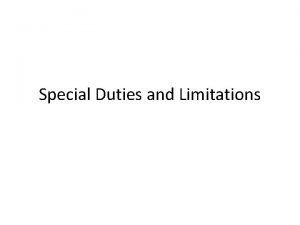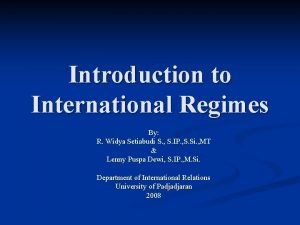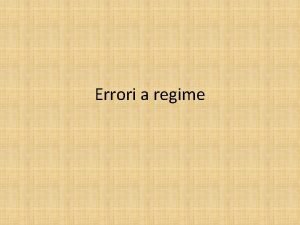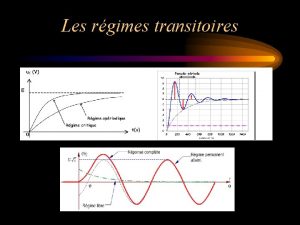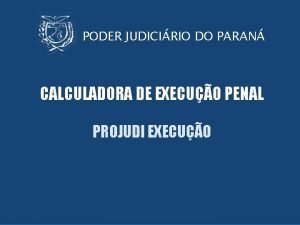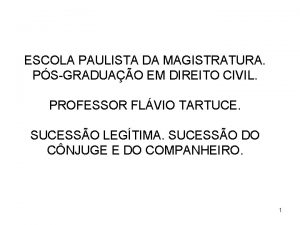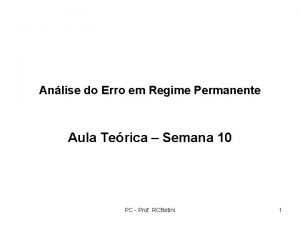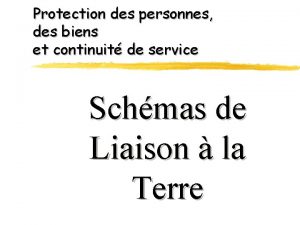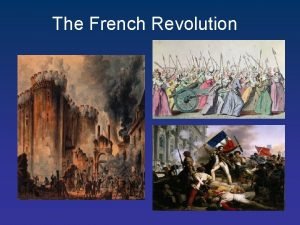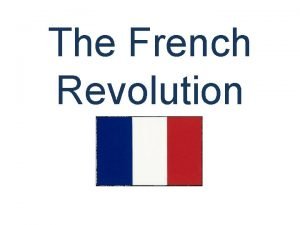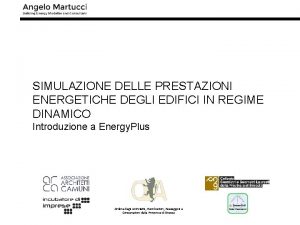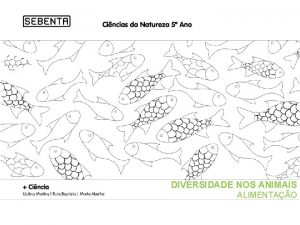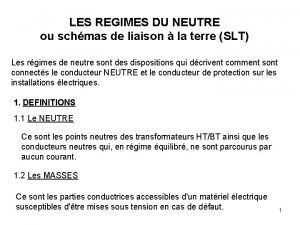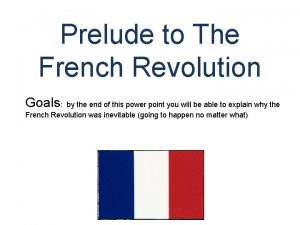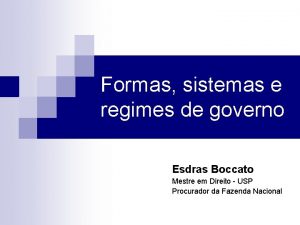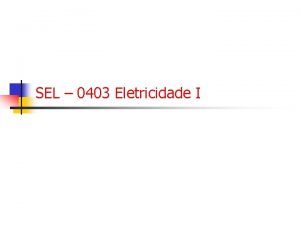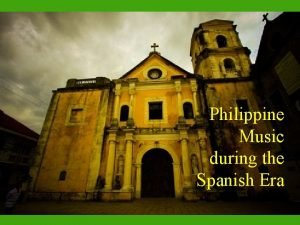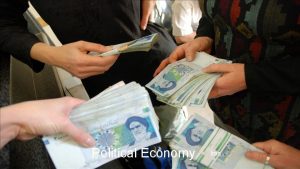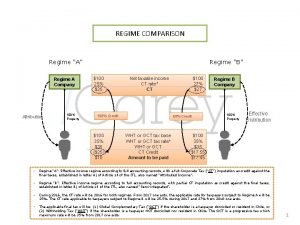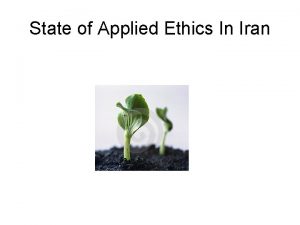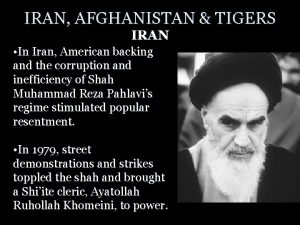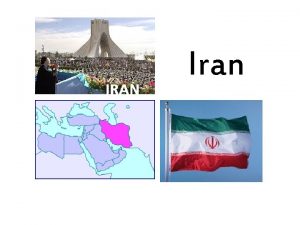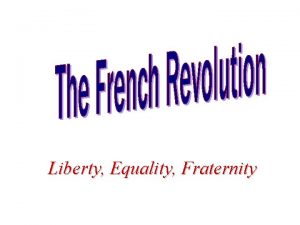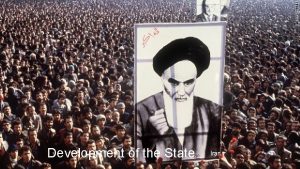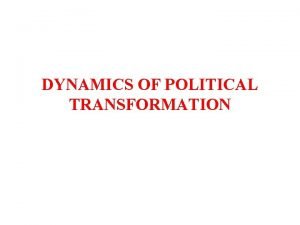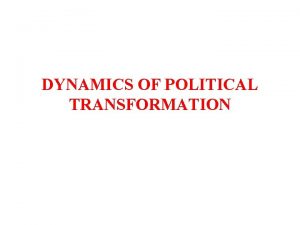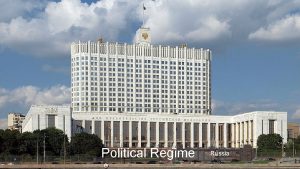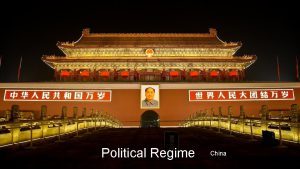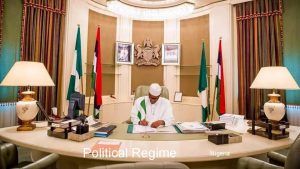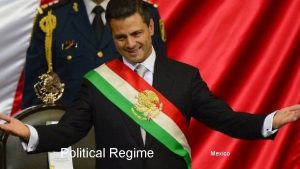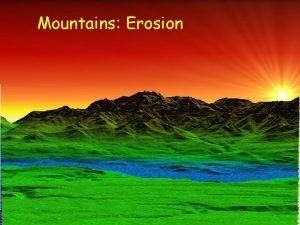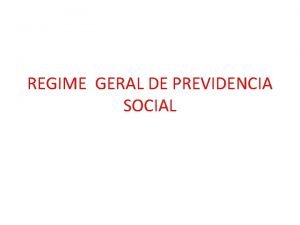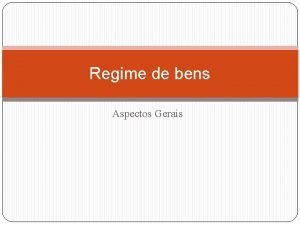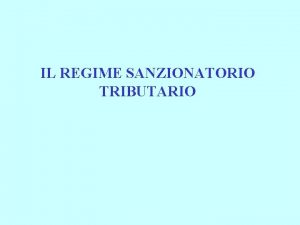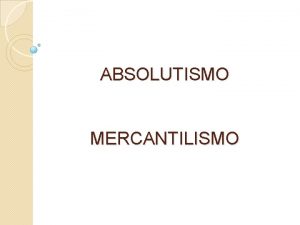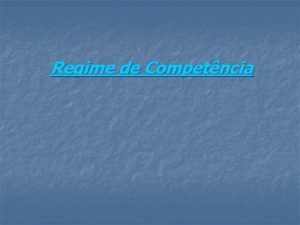Political Regime Iran Iran intro What are the




































- Slides: 36

Political Regime Iran

Iran intro What are the institutions of Iran’s government?

Constitution Iran

Iran Constitution The constitution of 1979 is a product of the Islamic Revolution Since its creation the only major changes were made ten years later The preamble says the current regime is a revolt against the “American conspiracy” of the White Revolution The govt exists to guide the people toward the will of God All political acts are expected to flow from the word of Allah

Iran Constitution All civil, penal, financial, economic, administrative, cultural, military, political, and other laws and regulations must be based on Islamic criteria” Sharia (God’s law) should reign supreme The Iranian constitution & political institutions attempt to express God’s will It also embodies republican elements – recognizing that the overthrow of the shah was a revolution led by the people The result is ongoing political tension between republicanism and theocracy

Iran Constitution The result is a set of institutions that are bewildering to outsiders Political institutions are consistent with velayat-e faqih This is seen most clearly in the dual executive

Supreme Leader & President Iran

Iran Supreme Leader The dominant executive is the supreme leader. This position was created for Khomeini It’s the most powerful office in Iran It ensures that a senior cleric is at the helm of Iranian politics always The supreme leader serves for life – but in theory can be removed for failure to uphold his religious duty

Iran Supreme Leader His powers are indirect – not formally in the constitution – but derive from practices institutionalized under Khomeini Supreme leader is commander in chief He has control over the Guardian Council which vets candidates for elections He appoints the chief justice and has significant influence over the judicial branch He has control of state owned assets, not subject to review by other branches

Iran Supreme Leader He can be seen as the head of state because he embodies the people He seems much more like a traditional monarch than a modern executive He has control over the Guardian Council which vets candidates for elections Since 1989 the supreme leader is Ali Khamenei, who was president from 19811989. He was not an ayatollah The constitution was changed and he was promoted to ayatollah since the constitution says the SL must be

Iran Assembly of Experts Supreme Leader In theory, the supreme leader is chosen by the Assembly of Experts They are 88 men who are Islamic scholars They are popularly elected for 8 year terms The constitution says they can remove the supreme leader if he fails to do his constructional duties The candidates for the assembly are vetted by the Guardian Council, limiting people’s choice

Iran President The president is more like the head of government than head of state He is directly elected and can only serve two four year terms. He directs policy, drafts the budget, initiates legislation, & appoints cabinet He cannot veto legislation or dissolve the legislature to call for new elections. He is technically in charge of foreign policy, but not in charge of the military.

Iran President The president was expected to be a nonreligious position that was more concerned with “worldly affairs” From 1981 -2005 the position was primarily held by clerics In 2005 Mahmoud Ahmadinejad was election with a background in higher education and local govt, not theology He emphasized social justice and confrontation with the West His support seemed to rival Khamenei’s but his powers were significantly checked in his second term.

Iran President Since 2013, President Hassan Rouhani has been president He is a cleric, and pursued a more reformist & less confrontational agenda He seeks the support of the supreme leader for his policies. The powers of the president are at their weakest since 1979.

Legislature Iran

Iran Majlis Legislature The Majlis is a unicameral body with directly elected members It has 290 members that serve four year terms. They must be at least 30. It can initiate and pass legislation, oversees the budget, and approves members of the president’s cabinet. Cabinet members can be removed by a vote of no confidence, but not the president or supreme leader. There are 9 women in the Majlis, and single seats reserved for Zoroastrian & Jewish communities; 3 for Christians.

Iran Majlis Legislature The Majlis has limited power because of the nature of the govt Man made laws are liable to deviate from God’s will. It should technically legislate in accordance with divine law, so its legislation can be struck down if it doesn’t It does not challenge the supreme leader, but does have conflicts with the president over national policies It is also used by representatives to gain resources through “pork barrel” projects.

Iran Guardian Council Legislature Made up of 12 individuals who serve 6 year phased terms 6 are lawyers nominated by the chief justice & approved by the Majlis. 6 are clerics specializing in religious law and appointed by the supreme leader They review all legislation from the Majlis to ensure its compatibility with Islam. They send legislation back to the Majlis & if they can’t revise it the Expediency Council mediates. They also vet candidates for presidential & legislative elections.

Iran Expediency Council Legislature Serves as a kind of unelected upper house with substantial powers to restrict the work of the Majlis Its members (38 today) are appointed to 5 year terms by the supreme leader. Its final decision on policy cannot be overturned. They review all legislation from the Majlis to ensure its compatibility with Islam.

Judiciary Iran

Iran System Judiciary The legal system is derived from Sharia – religious law The idea or “rule of law” is viewed as an attempt by people to assume legal authority where God should be sovereign At the head of the system is the chief justice – appointed by the supreme leader for a five year term He must have an understanding of Sharia He oversees the appointment and removal of judges and manages the judicial institutions

Iran Supreme Court Judiciary The Supreme Court is the highest court of appeal It is staffed entirely by high ranking clerics chosen for their expertise in Sharia Only clerics (therefore men) can serve as judges.

Iran Judges Judiciary Judges have a lot of independence in interpreting the law. This often leads to contradictory opinions across the courts Outside observers think this makes the courts the most dysfunctional institutions in the country

Iran Revolutionary Courts Judiciary These are a legacy of the post revolutionary period when opponents of Khomeini were tried & executed They deal with cases of national security, such as public protests Iran executes the 2 nd highest number of people in the world after China. Execution is administered mostly for criminal offenses such as murder and drug smuggling.

Elections Iran

Iran Elections Iran has some elements of democratic participation The Majlis are directly elected, as are the Assembly of Experts, and the president The 2013 presidential election had 73% voter turnout – they take participation very seriously Even though they vote, the people’s choices for representation are restricted. Majlis & Assembly have a mix of SMD and MMD

Iran Guardian Council Elections The Guardian Council has power to oversee all elections They can reject any candidate for office. (They are all unelected) In 2008 and 2012 elections for Majlis – 40% of all candidates were barred, eliminating all reformers They can also bar standing officials from running for reelection This has served to keep the Majlis and presidency under conservative control Reformers like Rouhani can get through if they are seen as not a likely threat

Iran Voting Elections There is universal suffrage for those over 18 ( it was lowered to 15 in the 1990 s) For Majlis elections, there are some MMDs and votes have a number of votes equal to the number of seats being voted on Any candidate who gets 25% gets a seat and the other seats are filled by runoffs The Assembly of Experts is elected in a similar war The president is elected directly by majority vote. The top 2 vote getters have a runoff if there is no majority

Revolutionary Guard Iran

Iran Revolutionary Guard A paramilitary force that has been around since the 1979 revolution It had the immediate task of defending the new regime and destroying rivals It expanded during the Iran-Iraq War to serve as an actual military force It relied on a people’s volunteer militia, the Basij that was a grassroots civil defense force. Basij members were poorly trained but had nationalist and religious fervor

Iran Revolutionary Guard At the end of the war, both continued to play a role in Iranian politics The Revolutionary Guard has become increasingly independent Its top leaders have taken on important roles in the state It has its own ministry, army, navy, and air force as well as significant economic assets in construction & communication It has an unclear role in the development of Iran’s nuclear program Its leaders content for economic and political power & support of the SL

Iran Basij Revolutionary Guard No longer a significant military force It also developed substantial economic assets It serves as a public morality force It bans public displays of affection and seizes illegal satellite dishes Its members tend to be poorer and the Basij serves as an opportunity to gain access to benefits like education

Local Govts Iran

Iran Local Govts Iran is divided into 30 ostan (provinces) with limited authority The 1979 Revolution made claims about needing local govt but didn’t devolve power – it centralized power Reforms in 1997 took power away from the Ministry of the Interior – which had appointed local governors & mayors Local councils now manage local politics and the elections of mayors Candidates for mayor must be approved by the Majlis – which is not as strict as the Guardian Council

Ayatollah’s Advice Iran

Main Ideas Iran Supreme Leader Role of President Majlis & Elections Guardian Council Ayatollah’s Advice
 Mikael ferm
Mikael ferm Rex erreur médicamenteuse
Rex erreur médicamenteuse Spinning jenny
Spinning jenny Regime de competencia
Regime de competencia Self contained regime
Self contained regime Guinier regime
Guinier regime Regime sinusoidale
Regime sinusoidale Regime douanier
Regime douanier Um gás escoa em regime permanente no trecho de tubulação
Um gás escoa em regime permanente no trecho de tubulação Transistor emetteur commun
Transistor emetteur commun Situational analysis first aid
Situational analysis first aid Old regime 3 estates
Old regime 3 estates Beggs and brill pressure drop calculation
Beggs and brill pressure drop calculation Special regime of duty
Special regime of duty Regime example
Regime example Errore a regime
Errore a regime Régime permanent et transitoire
Régime permanent et transitoire Regime alpino
Regime alpino Calculadora projudi
Calculadora projudi Regime dell'interesse semplice
Regime dell'interesse semplice Maintenance phase tb
Maintenance phase tb Tabela regime de bens
Tabela regime de bens Regime permanente
Regime permanente Régime it cpi
Régime it cpi Albertis regime
Albertis regime The ancien regime
The ancien regime Ancient regime
Ancient regime Gik regime
Gik regime Simulazione energetica in regime dinamico
Simulazione energetica in regime dinamico Régime hypoprotidique exemple
Régime hypoprotidique exemple Animais granívoros
Animais granívoros Schéma de liaison it
Schéma de liaison it What is the old regime in france
What is the old regime in france Sistema de governo
Sistema de governo Regime permanente senoidal
Regime permanente senoidal Philippine music in spanish period
Philippine music in spanish period Ochsner sherren regime
Ochsner sherren regime


